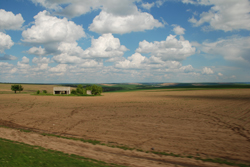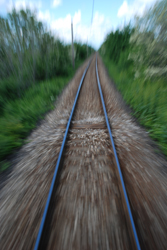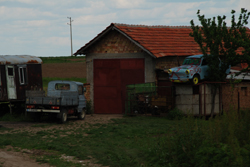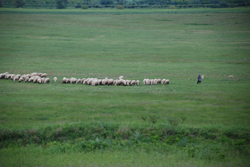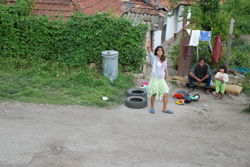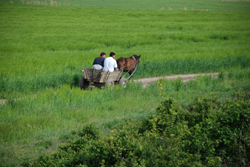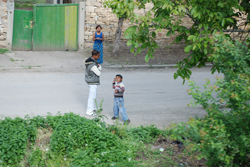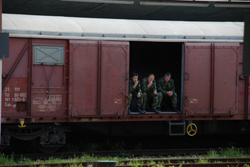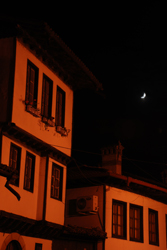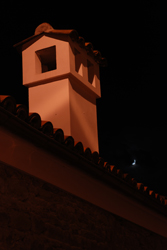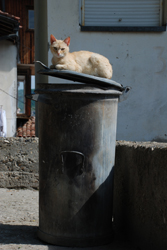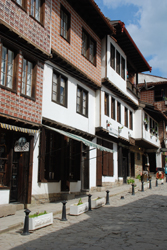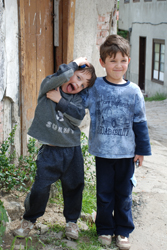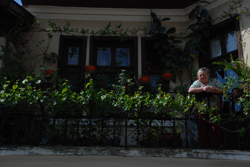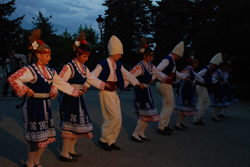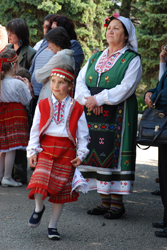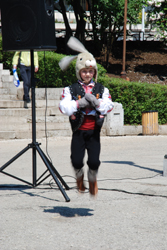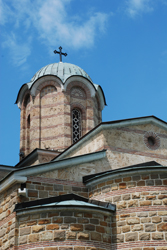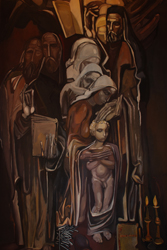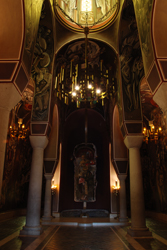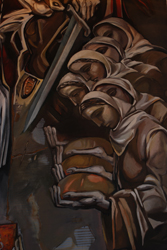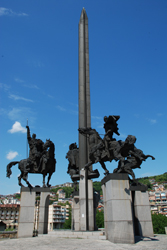Veliko Tarnovo: A Bulgarian Hill Town
12 May, 2008, 12:46 am in "Bulgaria"
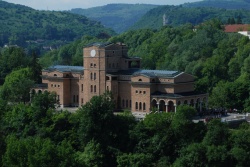 The region around Veliko Tarnovo seems to be where the flatlands end and the foothills begin.
The region around Veliko Tarnovo seems to be where the flatlands end and the foothills begin.The hills are thickly covered with trees. Light gray cliffs form Cheshire cat grins at the tops of the hills. Here and there rivers loop beneath the tracks and alongside the railroad. People, farmlands, and other railroad scenes flow by.
The train stations and buildings alongside the track are mostly of the sad boxy concrete variety. Veliko Tarnovo, besides being located in the hills, stands out due to its height above the tracks. Though its status as a city is visually apparent from the many concrete apartment buildings, the prominent feature is a pretty church floating above the trees, looking down on the river which wraps around the base of the hills.
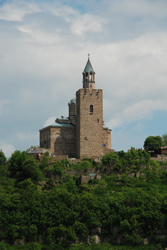
Though it has its share of modern boutiques, bars, restaurants, and an overabundance of real estate agencies with ads in English, farther up the hill, these all seem to fade away to reveal an extremely cute old town with stone arches, white washed walls, art galleries and souvenir shops. The streets become narrower and the pavement is replaced with flagstones.
The hostel we stayed in was even farther up the hill. Below it was the river chasm and rising across the river was the fortress walls and church.
We settled in then went down town where we caught the end of the days performances, part of a 2 week long Balkan folk festival. Older women in traditional costumes sang and danced.
We settled in then went down town where we caught the end of the days performances, part of a 2 week long Balkan folk festival. Older women in traditional costumes sang and danced.
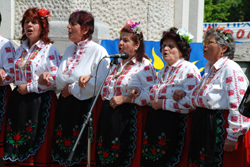
There were accordions, davuls, and kemances. There were also younger participants, kids and teens who danced and sang.
Around 9 we went to a restaurant that was considered one of the best in town. However, after receiving only one of our dishes after an hour and a half. And then waiting another half hour for another until we were eventually informed (after numerous questioning) there had been a mistake and it had never been started, we took our painfully empty stomachs to another restaurant, where I am happy to say we were served in a more timely manner, enabling us to finish dinner before midnight.
Although the train to Istanbul stops in Veliko Tarnova on Sundays, it turns out you cannot buy tickets there since the international ticket seller doesn't work on Sunday. So, Deena and I took a bus to Gorna Orjahovitca to buy the tickets. Since a lot of people don't speak English, I'd been attempting to communicate using the shreds of Russian I remember. Many words are the same but some are completely different. On the bus, I asked for 2 tickets to Gorna Orjahovitsa. The conductor shook her head "no" and proceeded to sell us 2 tickets. I was confused for a moment until I remembered reading somewhere that Bulgarian body language for "yes" is shaking the head left to right, in a gesture which looks like "no" in every other European country. No is a wobbly head movement. Comforted by this realization, we settled in for the ride. Since I didn't know where our stop was, I asked someone at the first stop if it was Gorno Orjahovitsa. She wobbled her head accompanying the gesture with a finger wag which resembled a softened scolding gesture, "Uh uh...no you don't" . I asked the conductor if she would let me know when we reached the town. She gave me the negative looking head shake which was accompanied by, "Da", yes. Surprisingly, she had indeed understood me and let us know when we got to our stop, a fortunate thing since even though it is a main train crossroads, GO seemed to just be a few apartment blocks and a tiny block of restaurants and stores. The train station seemed to be almost the same size as the rest of the town.
We got our tickets and headed back to Veliko Tarnova where we stopped by a cafe then walked to the fortress past another church, some more quaint houses and some more real estate offices.
Although the train to Istanbul stops in Veliko Tarnova on Sundays, it turns out you cannot buy tickets there since the international ticket seller doesn't work on Sunday. So, Deena and I took a bus to Gorna Orjahovitca to buy the tickets. Since a lot of people don't speak English, I'd been attempting to communicate using the shreds of Russian I remember. Many words are the same but some are completely different. On the bus, I asked for 2 tickets to Gorna Orjahovitsa. The conductor shook her head "no" and proceeded to sell us 2 tickets. I was confused for a moment until I remembered reading somewhere that Bulgarian body language for "yes" is shaking the head left to right, in a gesture which looks like "no" in every other European country. No is a wobbly head movement. Comforted by this realization, we settled in for the ride. Since I didn't know where our stop was, I asked someone at the first stop if it was Gorno Orjahovitsa. She wobbled her head accompanying the gesture with a finger wag which resembled a softened scolding gesture, "Uh uh...no you don't" . I asked the conductor if she would let me know when we reached the town. She gave me the negative looking head shake which was accompanied by, "Da", yes. Surprisingly, she had indeed understood me and let us know when we got to our stop, a fortunate thing since even though it is a main train crossroads, GO seemed to just be a few apartment blocks and a tiny block of restaurants and stores. The train station seemed to be almost the same size as the rest of the town.
We got our tickets and headed back to Veliko Tarnova where we stopped by a cafe then walked to the fortress past another church, some more quaint houses and some more real estate offices.
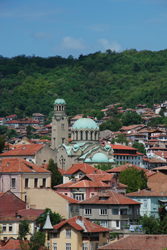
The fortress is a couple gates and a series of walls enclosing a large area. Inside are a mishmash of ruins: Roman and Byzantine columns, restored tower walls, a church foundation.
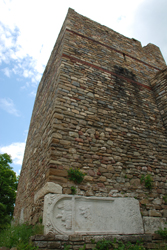
At one end we saw a tree with pretty red and white yarn bracelets tied to it. We overheard a Bulgarian man explaining to a group that it was a tradition of welcoming spring. When the first swallows return from Africa, you must tie a bracelet on the first tree which has flowers for good luck.
The church which crowns the fortress and town is a small chapel in the typical Bulgarian style with metal domes and bricks. The inside was entirely painted with very modern looking expressionist religious scenes.
While Deena and I had been off chasing train tickets, Rowshan had a chance to visit another structure in the town with a statue of horsemen near it.
Down by the river he met some kids and was shocked to realize they spoke Turkish. It turned out they were Turkish Romany who lived in Bulgaria.
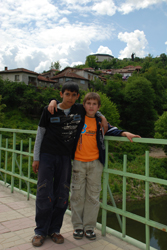
We spent the rest of our time eating dinner (at the restaurant that served food in a timely manner) and watching more music and dance performances.
[ View 1 Comments
|
]
Comments
Soyoung -
posted on 8/5/2008
Wow!!
I am here to see your blog.. What a funny experiance and nice photos..
I stand by your travel.
Hopely see you again oneday..
I am here to see your blog.. What a funny experiance and nice photos..
I stand by your travel.
Hopely see you again oneday..


